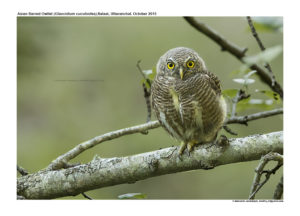
Asian Barred Owlet Glaucidium cuculoides
Etymology :
- Glaucidium : Greek for little owl derived fromglaux- owl
- Cuculoides: Latin word cuculus cuckoo; Greek word oides- resembling
Vernacular Names : Hindi: Bada dundul, Lepcha: Tanpum, Cachar: Dao ku-ra-ru-ru
Distribution in India: Resident of Himalayas and North East in India
Description: Size of 22–25 cm; Wt. of male is 150–176 g and wt. of female 240 g. it is a fairly large owlet with no “false eyes” on nape. The head is grey-brown, barred buff. It has whitish eyebrows; upperparts are dark brown, barred buff to fulvous; scapulars are edged buff-white, forming row of spots down sides of back. The tail and wings are dark brown and barred. It has white patches on throat and middle breast and rest of underparts are barred dark and light. The iris is yellow, bill is yellow-green and darker on cere. The feet is greyish-yellow or dull horn-green. Juvenile has breast streaked, not barred, and is more rufous on crown and mantle.
Habitat: It is found in open forest of pine and oak, subtropical evergreen jungle, scrub, gardens and cultivated areas near human habitation. It is found up to 2700 m.
Food habits: It eats mainly insects, including beetles, grasshoppers and cicadas, frogs, lizards, rodents and small birds. It is mostly diurnal. It hunts from perch, with undulating flight and catches birds such as Common Quail in air and insects in flight or on ground.
Breeding habits: They breed in Apr–Jun in India. The nest in an unlined tree cavity. It can kill Barbets and Woodpeckers to obtain nest cavity. They lay a clutch of 3–5 eggs. Both sexes incubate eggs and feed young.